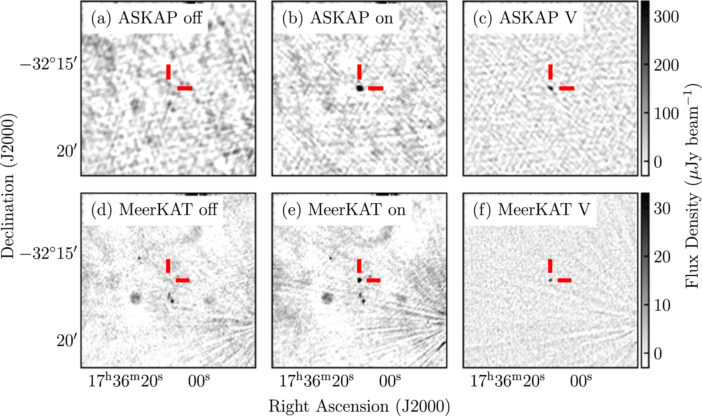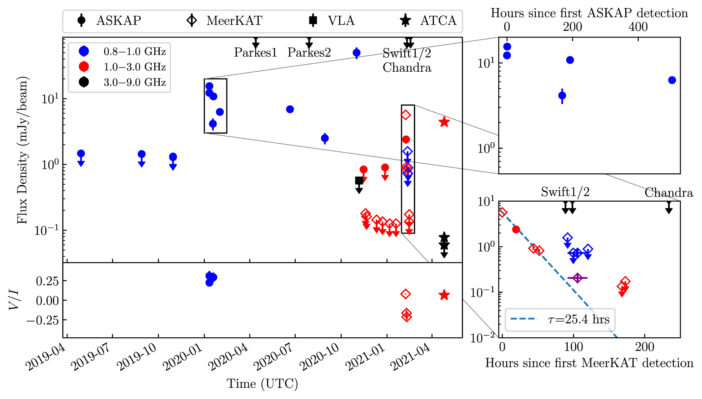Editor’s note: Astrobites is a graduate-student-run organization that digests astrophysical literature for undergraduate students. As part of the partnership between the AAS and astrobites, we occasionally repost astrobites content here at AAS Nova. We hope you enjoy this post from astrobites; the original can be viewed at astrobites.org.
Title: Discovery of ASKAP J173608.2–321635 as a Highly Polarized Transient Point Source with the Australian SKA Pathfinder
Authors: Ziteng Wang et al.
First Author’s Institution: The University of Sydney, Australia
Status: Published in ApJ
There seems to be a never-ending list of exciting radio sources within and outside of our galaxy. There are pulsars: a type of rapidly rotating neutron star. There are magnetars: neutron stars with extraordinarily powerful magnetic fields. There are flare stars: stars whose brightness will rapidly vary or “flare” in just a few minutes. There are supernovae and jets in active galactic nuclei. There are the galactic center radio transients: transient radio sources with unknown origins located toward the center of our galaxy. There are fast radio bursts: extremely energetic bursts of radio emission originating at extragalactic distances. On top of all of these, today’s authors present a possible new type of radio source: ASKAP J173608.2−321635.
What’s So Cool About This Source?
ASKAP J173608.2−321635 was first detected by a group of astronomers using the Australian Square Kilometre Array Pathfinder Variables and Slow Transients (ASKAP VAST) survey, a survey that focuses on finding transient objects whose emission changes on timescales down to ~5 seconds. After the initial detection, the team continued to monitor the source and detected it a total of six times over a nine-month period (see Fig. 1). They found that the flux was fairly steady on timescale of a few hours and persistent yet variable on the longer timescale of a few weeks. They then observed the source with the radio telescope MeerKAT in South Africa, which allowed them to search for pulsar-like emission (pulsed emission) and continuum (constant) emission. Since MeerKAT operates in a different frequency regime, this also allowed them to study the frequency dependence of the source.

Figure 1: Detections of ASKAP J173608.2−321635 with ASKAP and MeerKAT. Both “on” (i.e., pointed at the source), “off” (i.e., pointed away from the source), and Stokes V (which quantifies the circular polarization of the source) images are shown. [Wang et al. 2021]
- significant circular polarization and high levels of linear polarization
- a steep, negative spectrum, meaning that the flux decreases sharply as frequency increases
- a rapidly decreasing flux with a characteristic timescale of decay of ~26 hours (see lower right panel of Fig. 2)
- no variability on the timescale of ~minutes
In addition to radio observations with ASKAP and MeerKAT, the authors also looked for non-radio emission from the source in archival X-ray and near-infrared data, as well as in their own observations using the Neil Gehrels Swift Observatory and the Chandra X-ray Observatory. They didn’t find any significant emission in their searches, though.

Figure 2: Observed fluxes for observations at different frequencies and with different radio telescopes. Upper limits on emission are shown with downward errors. Note in the lower right panel how the emission decreases with time for the MeerKAT observations, and how the flux spans almost two orders of magnitude. [Wang et al. 2021]
What Could It Be…
This source seems to have a lot of really interesting features, but there are already a lot of interesting radio sources out there. Let’s take a look at the similarities and differences between this source and other radio sources to figure out a possible origin. Could it be…
- A star: Stars are one of a few sources that can emit polarized emission. However, X-ray and radio luminosities are typically correlated for these objects, so we would expect to detect X-rays from the source. Additionally, near-infrared emission would also likely be significant and detectable. So, unless our source has a really really small ratio of X-ray/infrared to radio emission, we can probably rule out a star. Buh bye stars!
- A pulsar: The steep spectrum and circular polarization of our source are very reminiscent of pulsars. However, the source shows no pulsed emission. It’s possible that it’s a highly scattered pulsar, a pulsar with an ultra-long period, or a pulsar in an eccentric binary system, but it doesn’t like look it could be your everyday pulsar.
- A magnetar: Magnetars tend to have very flat spectra (e.g., the intensity of the emission does not vary a lot as a function of frequency), which is very unlike our source! Magnetars also typically have periods of ~1–10 seconds, which is ruled out by the MeerKAT periodicity searches. However, there is the possibility that it is a special ultra-long period magnetar.
- A jet, gamma-ray burst, supernova, or tidal disruption event: Again, not looking so likely. The levels of circular and linear polarization, the steep spectra, and the short timescale over which it decayed make all of these very unlikely.
- A galactic center radio transient: We actually might have something here! Galactic center radio transients similarly have steep spectra, are highly polarized, and have no X-ray emission. However, only three galactic center radio transients have been detected and their origins, if they are even the same, are still uncertain. Additionally, the timescale over which the emission varies for ASKAP J173608.2−321635 doesn’t match the timescales of other galactic center radio transients.
What Should Our Takeaway Be?
It seems like this source is definitely not a typical pulsar, magnetar, or star. The authors seem to be leaning toward a new type of source, which might be related to galactic center radio transients, or might be the first of its kind. The only way to find out is to keep observing!
Original astrobite edited by Ishan Mishra.
About the author, Alice Curtin:
I’m a PhD student at McGill University studying fast radio bursts and pulsars using the Canadian Hydrogen Mapping Experiment (CHIME). My work mainly focuses on characterizing radio frequency interference, investigating possible relationships between gamma-ray bursts and FRBs, and using pulsars as calibrators of future radio instruments. When not doing research, I typically find myself teaching physics to elementary school students, spending time with friends, or doing something active outside.

